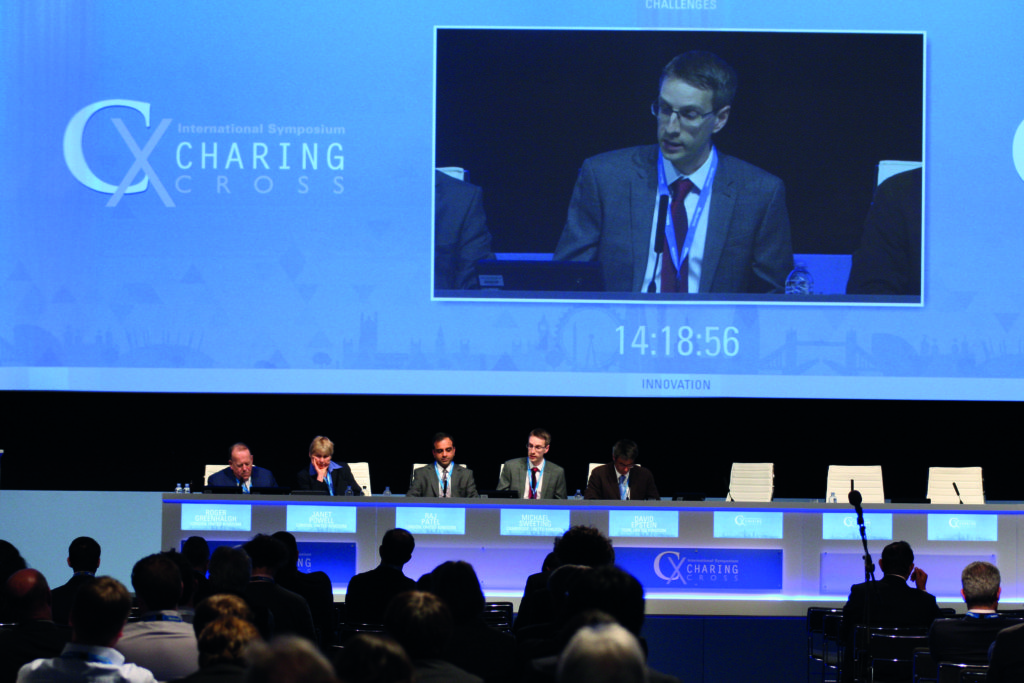
The teams of researchers and principal investigators who collected and analysed the data for the Individual Patient Data meta-analysis and EVAR 1 trial presented the data in the session titled “EVAR follow-up and avoidance of secondary sac rupture and death” at the 2016 Charing Cross Symposium (CX 2016; 26–29 April, London, UK).
The meta-analysis of Individual Patient Data from the EVAR 1, DREAM, OVER and ACE randomised controlled trials that compared elective endovascular and open repair of abdominal aortic aneurysm was presented by the trialists Pinar Ulug, London, UK, Michael Sweeting, Cambridge, UK, Janet Powell, London, UK, Jan Blankensteijn, DREAM principal investigator, Amsterdam, The Netherlands, Jean-Pierre Becquemin, ACE principal investigator, Creteil, France, and Roger Greenhalgh, London, UK.
The meta-analysis results revealed that overall, there was no difference with regard to survival benefit (total or aneurysm-related) between endovascular aneurysm repair (EVAR) and open repair over the first five years of follow-up.
The study investigators noted that IPD meta-analysis data are limited by the information that could be feasibly merged from the four trials, which together represent the early experience of endovascular vs. open repair. They also explained that there were variable reporting standards in the trials, but highlighted that this analysis produced amount of prospective data from a large number of individual randomised patients.
They reported that in the first six months after randomisation, total and aneurysm-related mortality was lower in the EVAR group so that patients who received the endovascular option had a favourable operative mortality. However, at 12 months, there was no difference between groups for Health Related Quality of Life. There was speculation about why the initial benefit of EVAR had eroded.
EVAR 1 15-year results
The new data from the EVAR 1 trial was a first time presentation of the eight to 15-year period. Greenhalgh, Raj Patel, London, UK, Sweeting, Powell, and David Epstein, York, UK, presented the results.
The panellists alluded to the fact that the data were based on devices that were implanted between 1999 and 2005. These were the first commercially available devices and the results of the trial were interpreted against the background of this early technology. The trial also provides a reflection of UK practice only, the panel noted. Currently, there has been rapid device development and there is now a new generation of devices available, which can be measured against the benchmark set by the EVAR 1 data.
The trialists were able to use the mortality data from the Office for National Statistics and the hospital episode statistics (HES) data for reinterventions to make good the shortfall in clinical follow-up.
The results showed that once again, there was a high reintervention rate in the group of patients receiving EVAR and that these reinterventions occurred throughout the follow-up period. The investigators reported that aneurysm-related mortality occurred throughout the follow-up period.
Greenhalgh concluded on behalf of his colleagues that that even with the data based on experience with these early devices, there was much to learn about the cluster awareness with regard to secondary sac rupture. Wyss et al’s 2010 publication in the Annals of Surgery showed that EVAR was associated with a rupture rate of 0.7 ruptures per 100 person-years. The paper showed that EVAR is associated with secondary sac rupture due to a “cluster of concerns”: type Ia or Ib endoleak; type II endoleak and sac expansion; type III endoleak; migration; and kinking. The mortality associated with secondary sac rupture was 67% and the investigators recommended surveillance follow-up to detect these.
“In many cases, this has been ignored in clinical practice to the peril of patients,” Greenhalgh commented.
The session brought to light that diligent and continuous assessment of sac diameter after aneurysm repair is the way forward.
The EVAR 1 data shed light on the fact that diseased aortas continue to dilate over time and that even a well-placed good device can leak later on. Panellists noted that patients should be followed-up better so that aneurysms do not get to the point of rupture. Experts commented that if the disease process could be controlled, the devices would perform better.
Atherosclerosis that is associated with dilatation is the disease of aneurysms, and it shows a relentless tendency to dilate, the CX audience heard. The session saw that there was a need to halt the progression of dilating disease and to encourage the development of devices to allow for aortic dilatation.
Delegates heard that the EVAR 1 data needed to be used as a benchmark of first experience. Further, there was a need to encourage surveillance, and have diligent, regular, easy and novel tracking of sac diameter.
The EVAR 1 trial randomised 1,252 patients between 1 September 1999 and 31 August 2004. Of these, 626 were assigned to EVAR and 626 were assigned to open repair.













